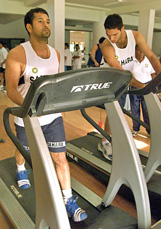COACHING
General Principles of fitness
Doctors prescribe medication to treat illnesses and
diseases. While they may give the same medicine to
different individuals suffering from the same
illness, they vary the 'dosage' of the medicine
from individual to individual. The same holds true
in the case of physical fitness. The exercises may
be the same, but their appropriate 'dosage' and
'intensity' should ideally vary from individual to
individual.
"Exercise prescription" should be tailored to meet
the needs of the individual. It comprises the
following :
Fitness Goals
Mode of exercise
Warm-up
Primary conditioning
Cool-down
Let's take a look at each of these factors:

I. FITNESS GOALS
Short-term and long-term goals are important
components of Exercise Prescription. Goals serve as
a motivation to commence an exercise programme.
A logical and common type of fitness goal is a
'performance goal'. However, short-term goals need
not be "fixed in stone", and can be modified if
required.
II. MODE OF EXERCISE
Every Exercise Prescription includes atleast one
mode of exercise - a specific type of exercise that
should be performed.
Take for instance, a fast bowler who wants to
improve his cardio-respiratory fitness, so that he
will be able to bowl a spell of 10-12 overs with
more or less the same strength and sting, and
subsequently give more than 100% as a fielder on
the third-man or fine-leg boundary. To enhance
cardio-respiratory fitness, he can choose from a
wide variety of exercise modes, such as running,
swimming or cycling.
III. WARM-UP
A warm-up can be defined as exercise for a brief
period of 5-15 minutes' duration, which precedes
the workouts. Its generally involves light
calisthenics; a low-intensity form of the mode of
the actual exercise, and often includes stretching
exercises. The purpose of warm-up is to ELEVATE
MUSCLE TEMPERATURE and increase blood-flow to the
muscles that will be engaged in the exercises. A
warm-up can also reduce the strain on the heart
that is imposed by heavy exercise, and it will
reduce the risk of muscle injuries.
IV. PRIMARY CONDITIONING
The major components that make up the primary
conditioning period are the mode of exercises and
their FREQUENCY, INTENSITY and DURATION.

FREQUENCY OF THE EXERCISE
'Frequency' refers to the number of times per week
that one should exercise. The recommended frequency
of exercises that will have a significant impact on
improving health and fitness is 3-5 times a week.
INTENSITYOF EXERCISE
It means the amount of physiological stress or
overload placed on the body while exercising. A
load that can be lifted only five to eight times
before complete muscular fatigue, is an example of
a high-intensity strength-training exercise. In
contrast, a load that can be lifted 50-60 times
without resulting in muscular fatigue is an
illustration of low-intensity strength training.
DURATION OF EXERCISE
The amount of time invested in performing the
primary workout. The duration of exercise does not
include the warm-up and cool-down exercises. A
period of 20-30 mins per session (thrice a week) is
the minimum amount of time required to
significantly improve physical fitness.
V. COOL-DOWN (sometimes called warm-up)
This is a 5-15 minute-long period of low-intensity
exercise that immediately follows the primary
conditioning period.
Slow walking can be used as a 'cool-down'. A
cool-down period accomplishes several goals.
During exercise, the heart pumps a large amount of
blood into the working muscles. The cool-down
period allows blood to return to the heart. While
the cool-down may not eliminate muscular soreness
entirely, it is entirely possible that the severity
of the exercise-induced muscle-soreness will be
less in people who perform a proper cool-down.